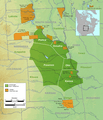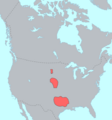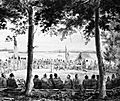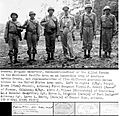Pawnee people facts for kids
| Chaticks si Chaticks | |
|---|---|
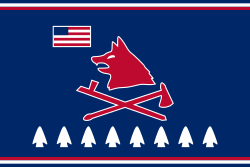
Pawnee Nation of Oklahoma tribal flag
|
|
| Total population | |
| 3,600 | |
| Regions with significant populations | |
| Languages | |
| English, Pawnee | |
| Religion | |
| Native American Church, Christianity, Traditional Tribal Religion | |
| Related ethnic groups | |
| Caddo, Kitsai, Wichita, Arikara |
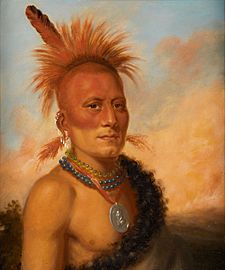
The Pawnee are a Native American tribe from the Plains Indians group. They mostly lived in areas that are now Nebraska and Kansas.
Unlike some other tribes of the Great Plains, the Pawnee were semi-nomadic. This means they moved around for part of the year. They were both hunters and farmers.
For most of the year, the Pawnee farmed and lived in special homes called earth lodges. During the buffalo hunting season, they lived in tepees. This allowed them to follow the large buffalo herds.
In the early 1800s, their main village was located on the south side of the Platte River in Nebraska.
Pawnee Way of Life
The Pawnee people were skilled farmers. They grew many different crops. These included beans, corn, pumpkins, squashes, and sunflowers.
The Pawnee were known for being brave warriors. They used special war paint and tattoos. These designs helped them look strong and fearless to their enemies.
Pawnee Bands
The powerful Pawnee tribe was made up of four main groups, called bands. Each band had its own leaders and traditions.
These four bands were:
- The Chaui (also known as the Grand Pawnee)
- The Kitkehaki (also known as the Republican Pawnees)
- The Pitahauerat (also known as the Tapage Pawnees)
- The Skidi (also known as the Loup or Wolf Pawnees)
Pawnee History and Challenges
The Pawnee were the largest tribe to live in Nebraska. They were also one of the first tribes to settle in that area. By the year 1800, it is thought that between 10,000 and 12,000 Pawnee people lived in Nebraska. Because they were such a large tribe, they had little to fear from other groups.
However, in the early 1800s, their numbers dropped a lot. This was mainly due to diseases like Smallpox. These diseases were brought by Europeans and Native Americans had no natural protection against them.
Finally, in the 1870s, the Pawnee people were moved to Oklahoma.
Images for kids
-
Tribal territory of the Pawnee and tribes in Nebraska
-
Pawnee lodges near Genoa, Nebraska (1873)
-
Pawnee Indians migrating, by Alfred Jacob Miller
-
Ornamental hair comb by Bruce Caesar (Pawnee-Sac and Fox), 1984, of German silver, Oklahoma History Center
-
Miniature model of the Morning Star ritual, Field Museum
-
A sketch of a Wichita Indian village in the 19th century. The beehive shaped grass-thatched houses surrounded by corn fields appear similar to those described by Coronado in 1541.
-
Pawnees in a parley with Major Long's expedition at Engineer Cantonment, near Council Bluffs, Iowa, in October 1819
-
General Douglas MacArthur meeting Navajo, Pima, Pawnee, and other Native American troops
See also
 In Spanish: Pawnee para niños
In Spanish: Pawnee para niños


